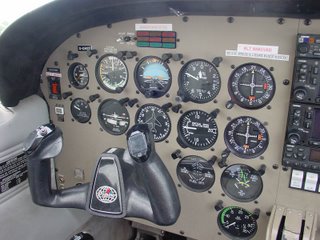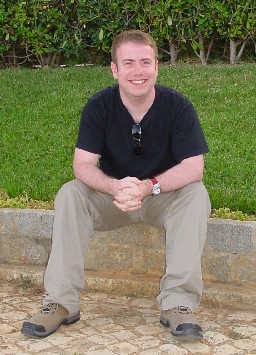Friday, June 30, 2006
Short circuit
With a new, improved Cabair checklist in hand I knew my stuff today: 'A' checks started to make sense and when to turn carburettor heat on or off was no longer some black magic or dark secret.
The school, however, was running late and my time was limited. Still, it was a return to circuits and my handling of the plane much improved compared to a couple of days ago. More to do during circuits though as discussed in a previous post: the sense of messiness continued therefore and with only three times around the airfield my last attempt was nowhere near last year's performance.
A similar problem as Tuesday as well: although I'm now flying the plane more I'd always been told to use a set of lights by the runway on approach to gauge whether I'm on the correct flightpath for touchdown. Two white and two red and you're perfect: more red and you're too low so feed in more power, more white and you're too high so take some power out. But, as my new instructor pointed out, this is all very well for big airfields like Biggin but smaller ones won't necessarily and how do I land then? Back to basics, choose an aiming point, fly the plane down.
The school, however, was running late and my time was limited. Still, it was a return to circuits and my handling of the plane much improved compared to a couple of days ago. More to do during circuits though as discussed in a previous post: the sense of messiness continued therefore and with only three times around the airfield my last attempt was nowhere near last year's performance.
A similar problem as Tuesday as well: although I'm now flying the plane more I'd always been told to use a set of lights by the runway on approach to gauge whether I'm on the correct flightpath for touchdown. Two white and two red and you're perfect: more red and you're too low so feed in more power, more white and you're too high so take some power out. But, as my new instructor pointed out, this is all very well for big airfields like Biggin but smaller ones won't necessarily and how do I land then? Back to basics, choose an aiming point, fly the plane down.
Tuesday, June 27, 2006
Just fly the plane
 I won't go into the whats, whys and wheres of returning to flying and to this blog after six months absence.
I won't go into the whats, whys and wheres of returning to flying and to this blog after six months absence.Today however I did return to the skies harnessing myself in and bracing myself for a frustrating lesson. That deft touch of the controls I'd developed, the near mastery of the circuit I'd assimilated.
Instead here I was bobbing up and down by +/- 100 ft, drifting off my compass heading and getting confused on my balance of power (the throttle), attitude (the pitch or 'angle of attack') and the trim (that handy control which locks in the pitch). It was probably my having re-read my notes over and over again.
A new teacher, a new style and new observations. The most important of which was that I was flying on instruments and responding to them. I'd locked in my mind that if this instrument does that I need to correct this way etc. But this flight, and my licence, is according to Visual Flight Rules (VFR) i.e. you can only fly if you can actually see the ground, a certain distance in all directions etc. I was barely looking out of the window, maybe a quick glance away from the instruments rather than the other way round. Given the instrument 'lag' I was over-compensating one way and then the other.
I can't be the only person to do this though as my instructor whipped out a couple of paper circles that were placed on and completely obscured the altimeter and other dials. All of a sudden we were straight and level... using the horizon and the 'four finger rule' (put four fingers on the dashboard and at the top of your fingers should be the horizon and that's your aspect to maintain).
You see and hear this kind of thing in films, don't you? Trust your instincts, feel the feedback, ignore the computer, use the force, just fly the plane.
